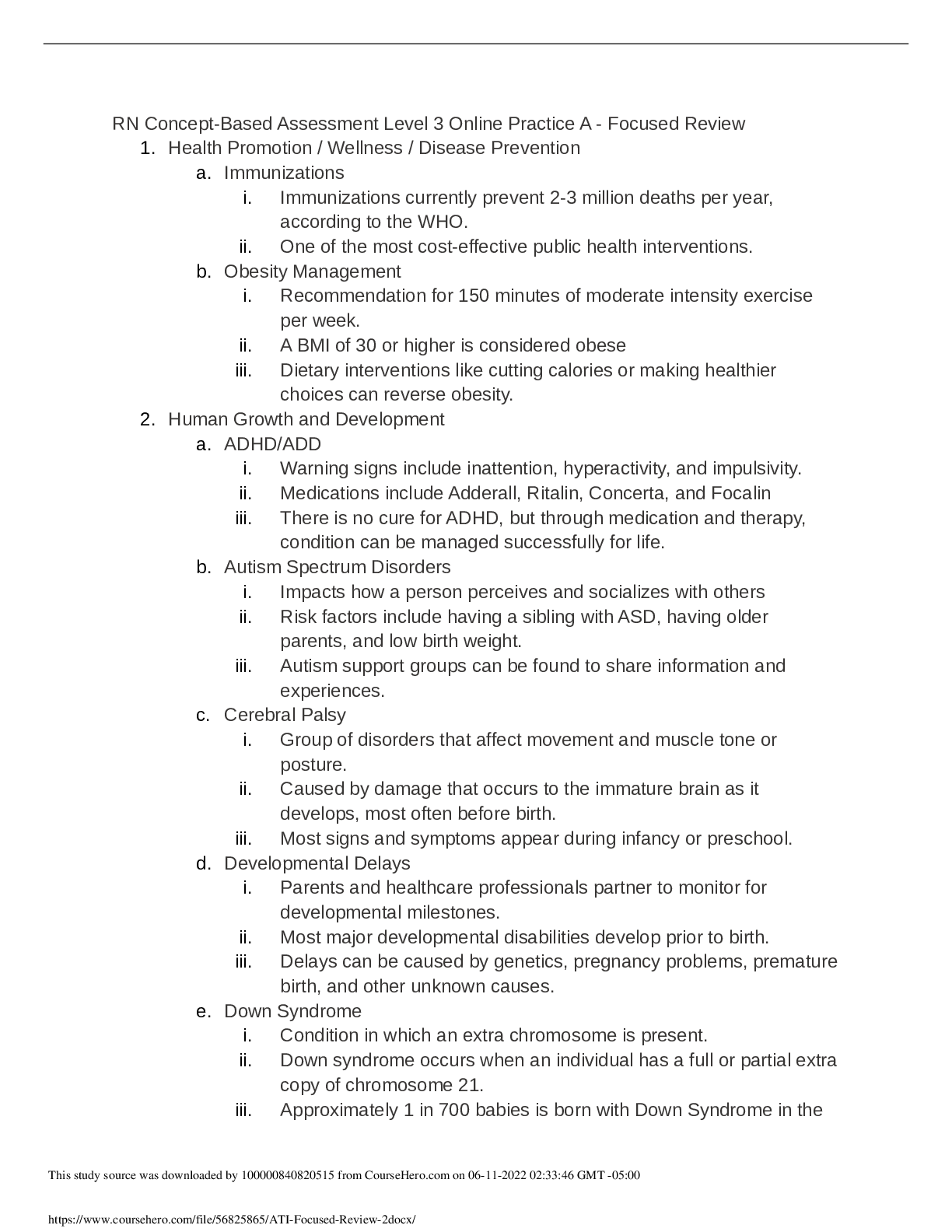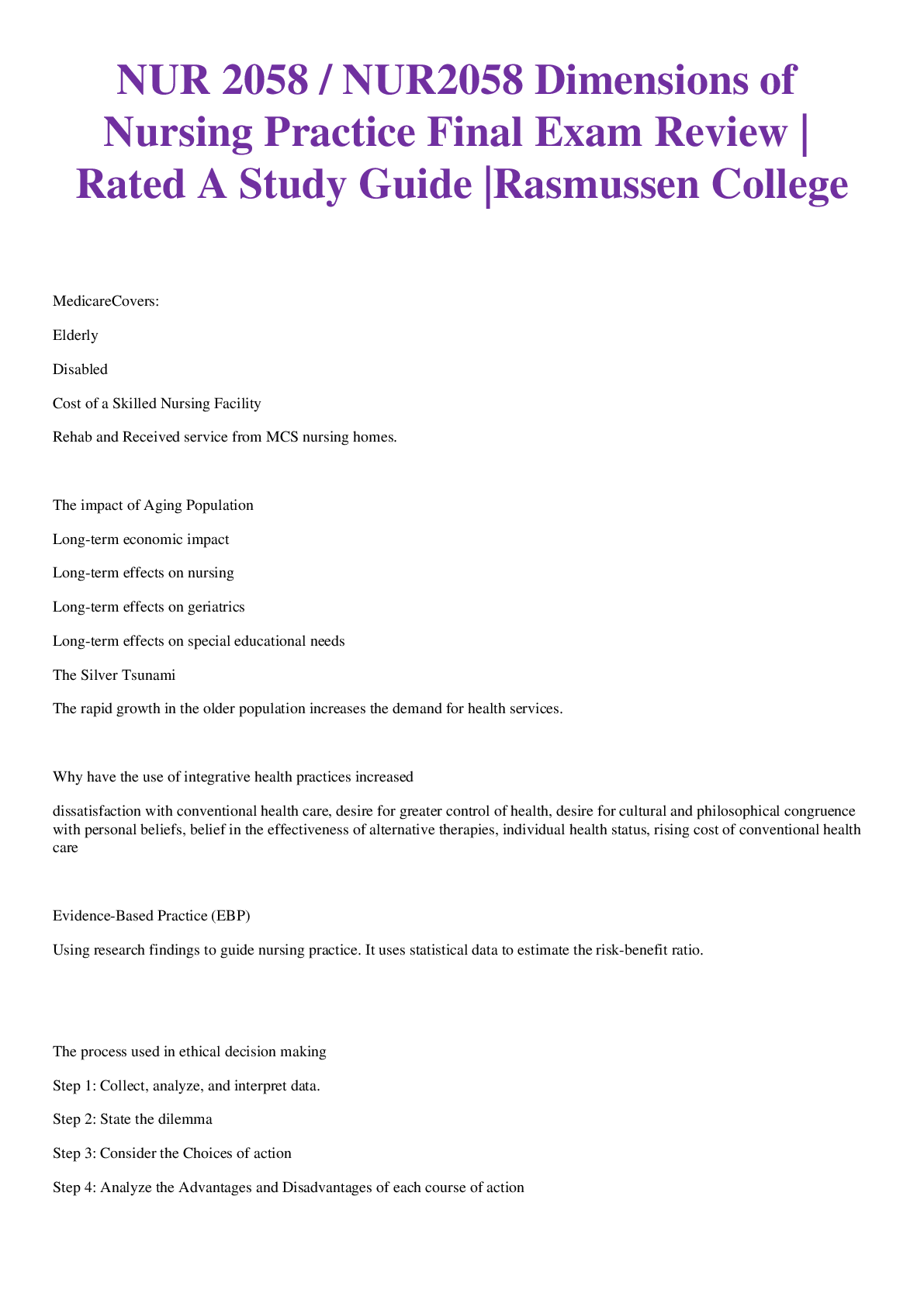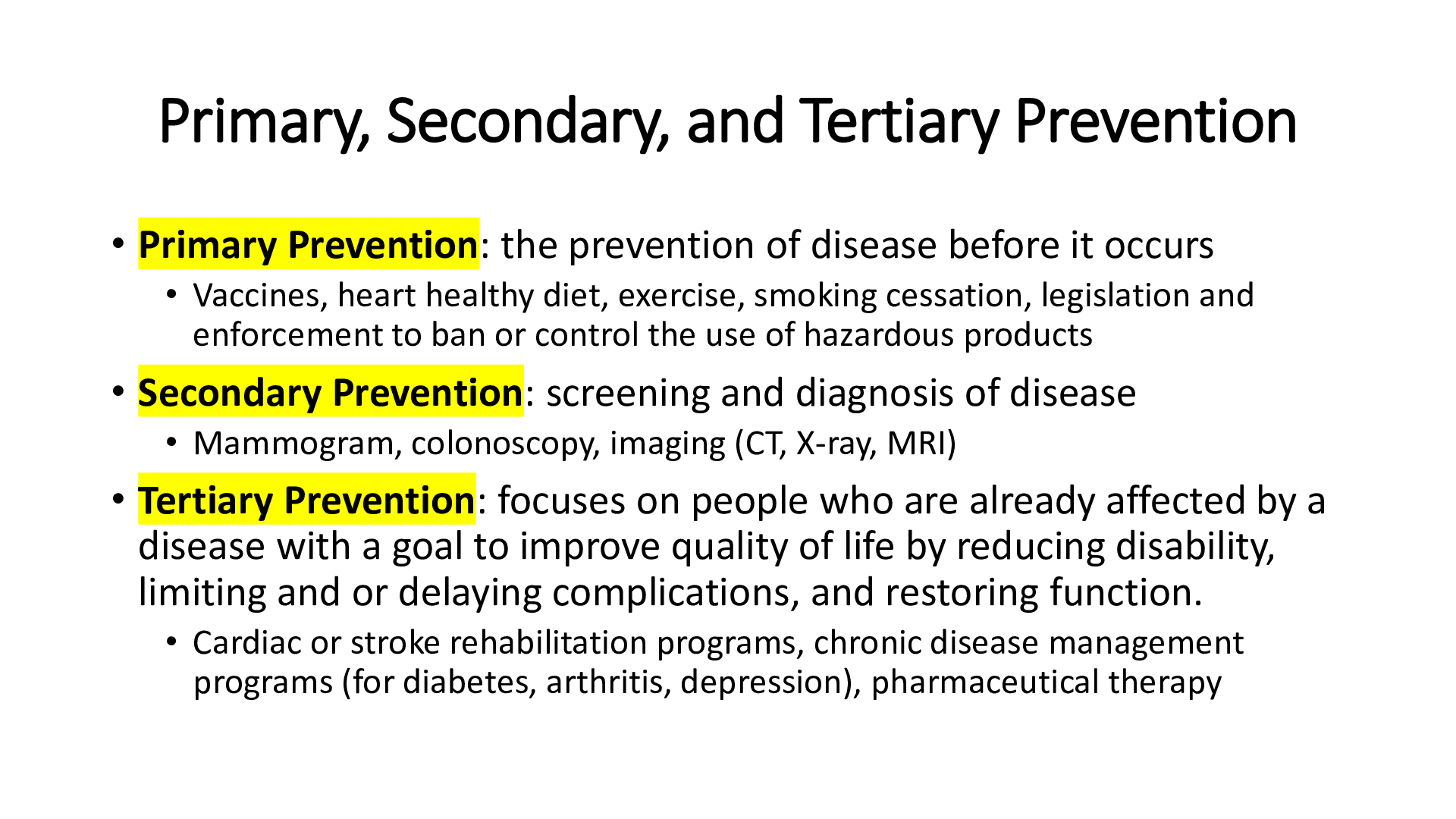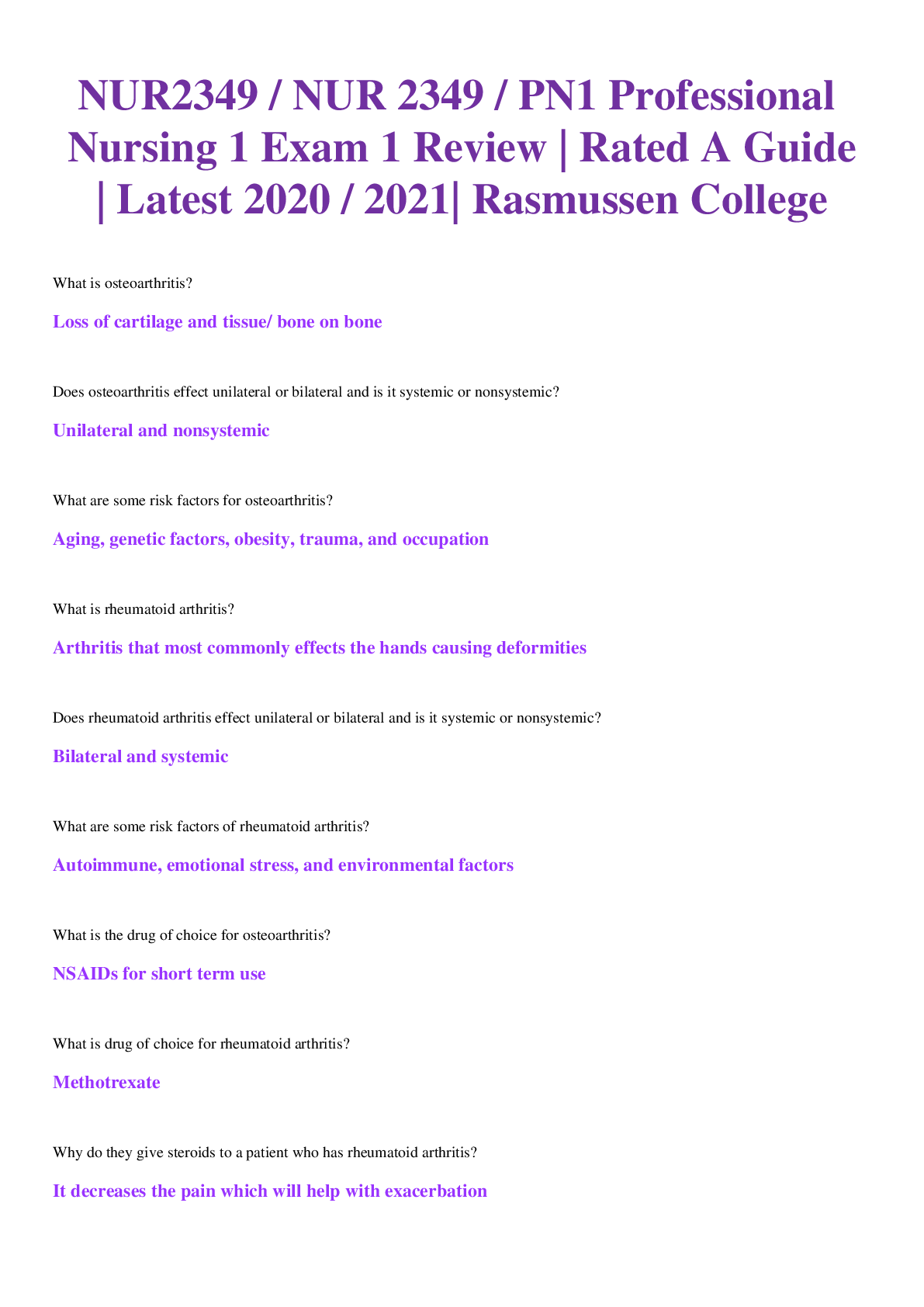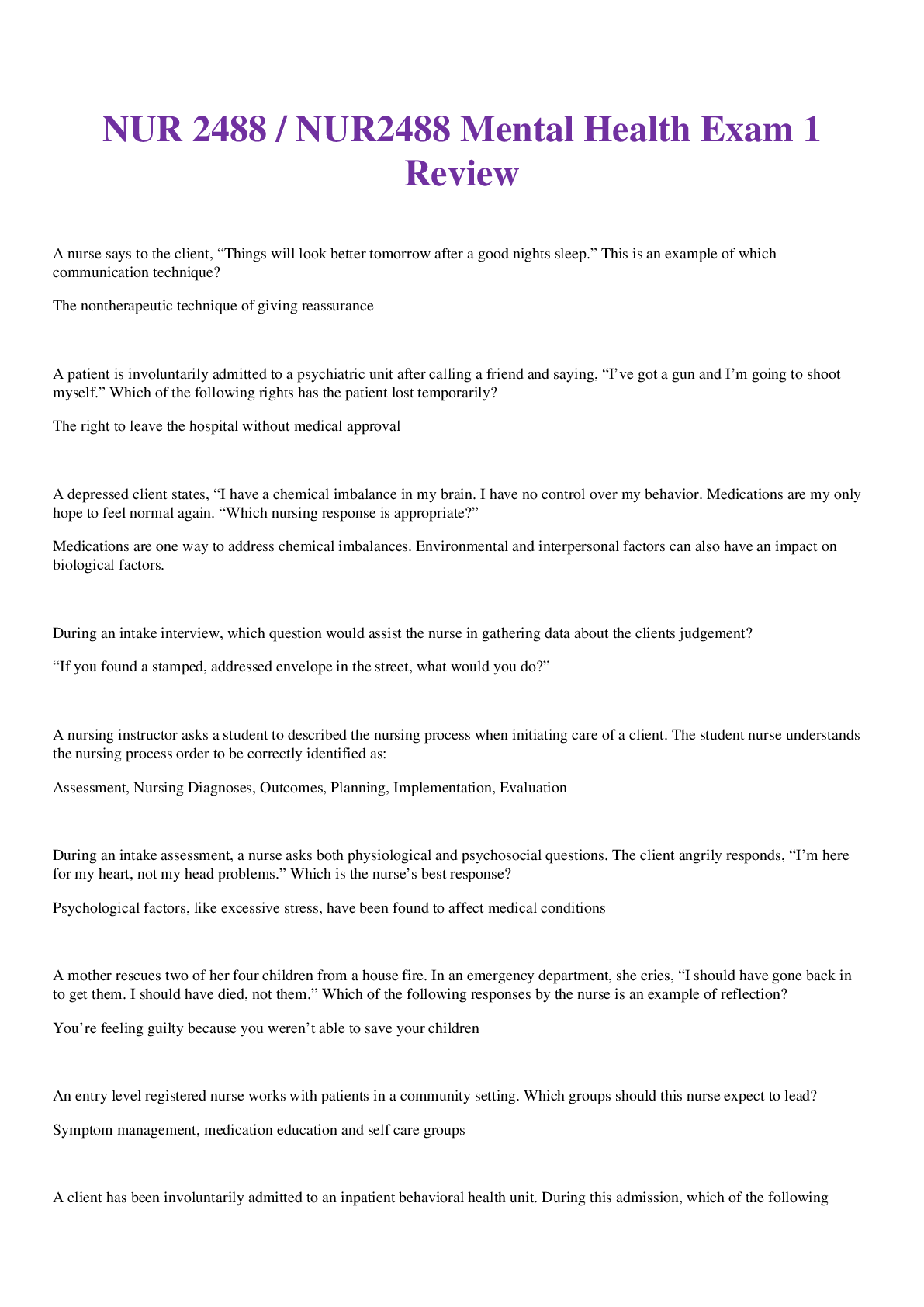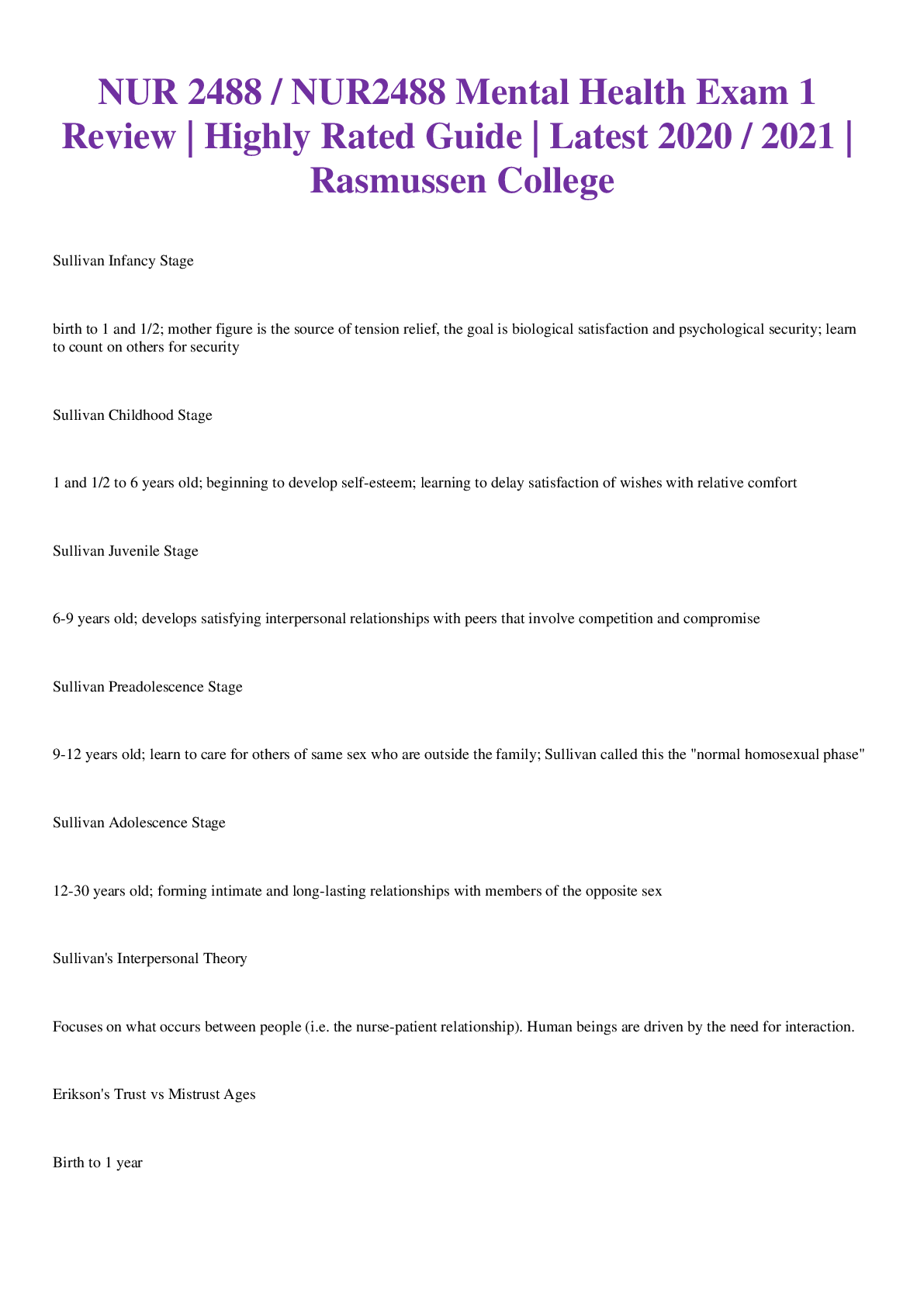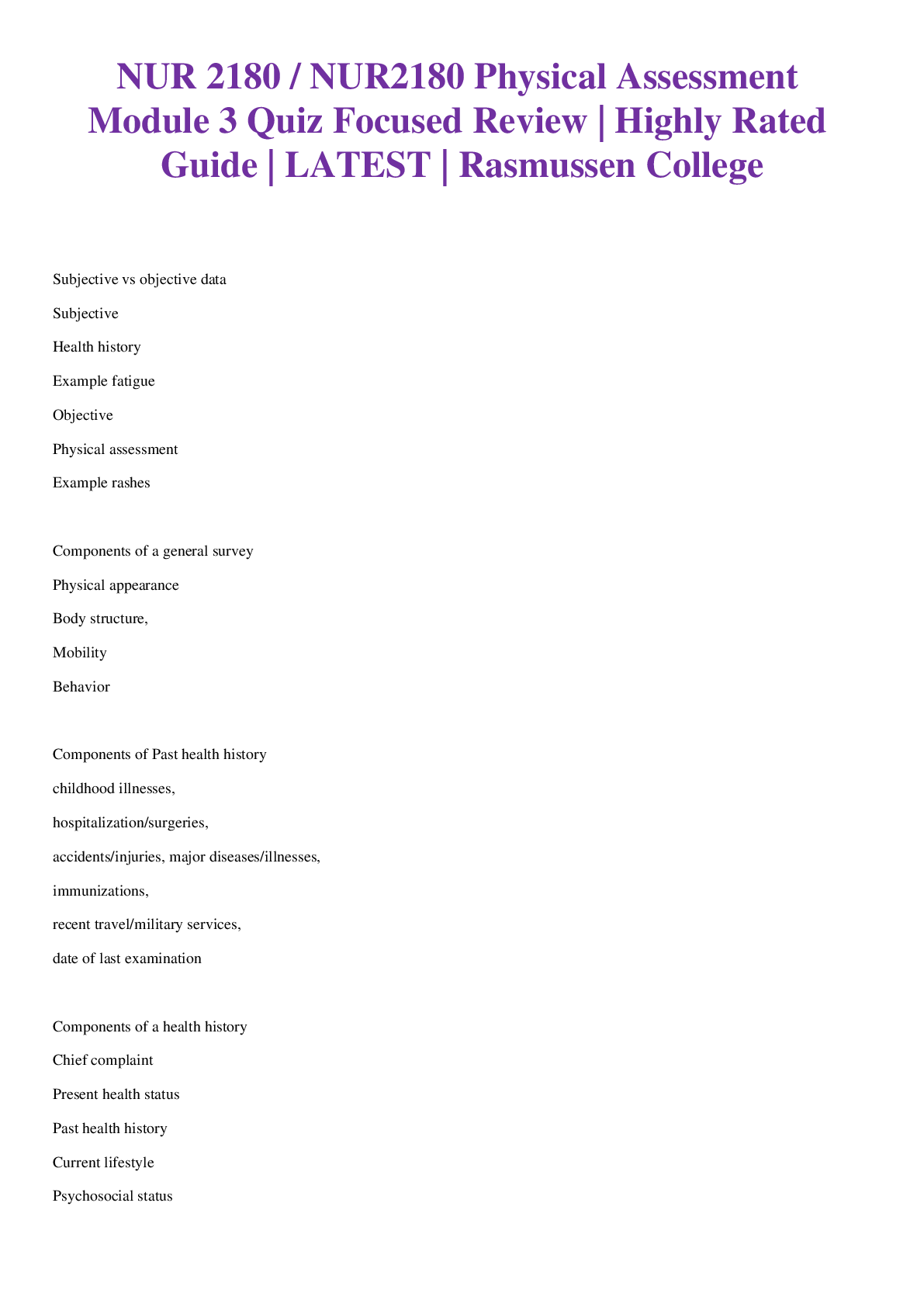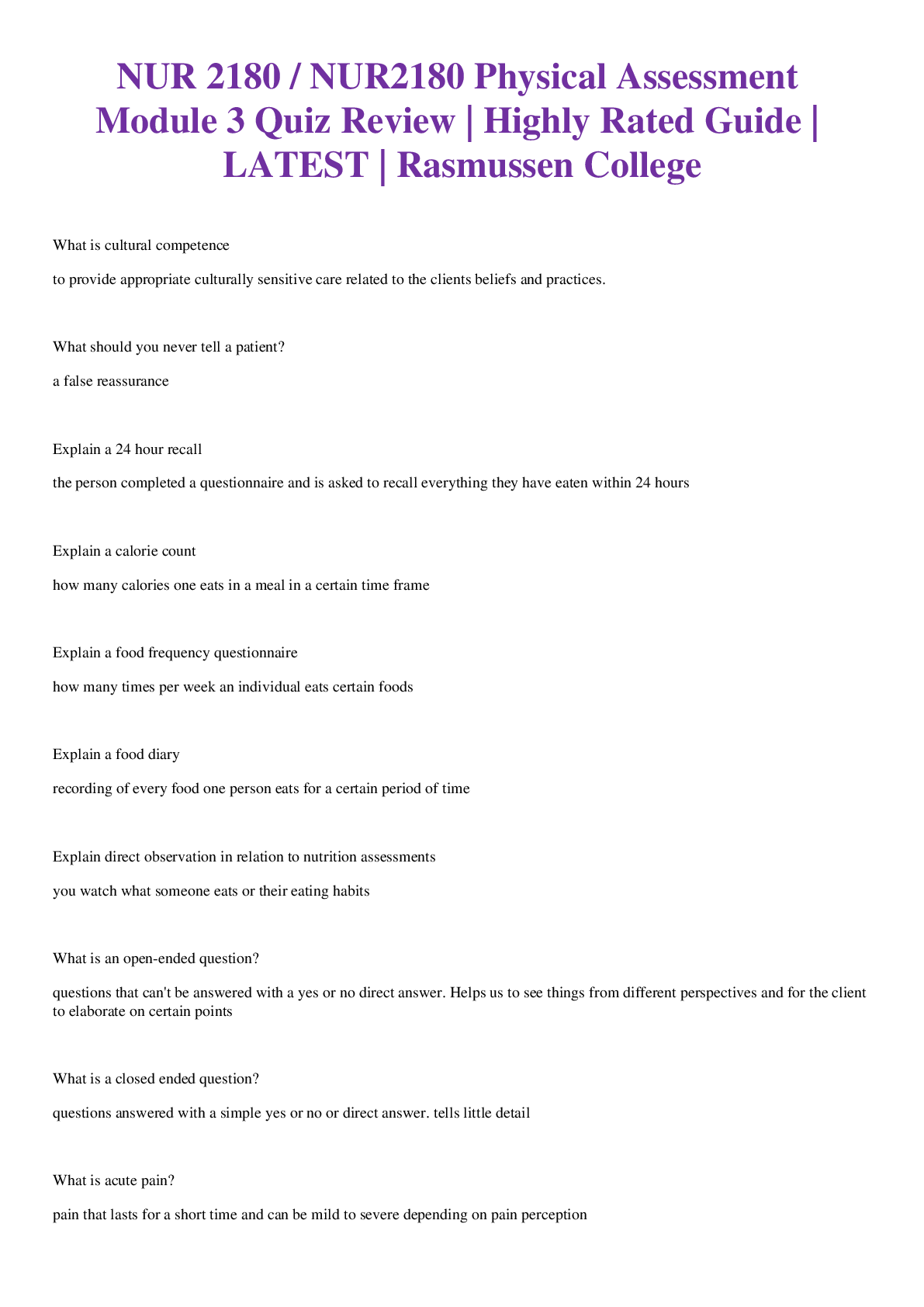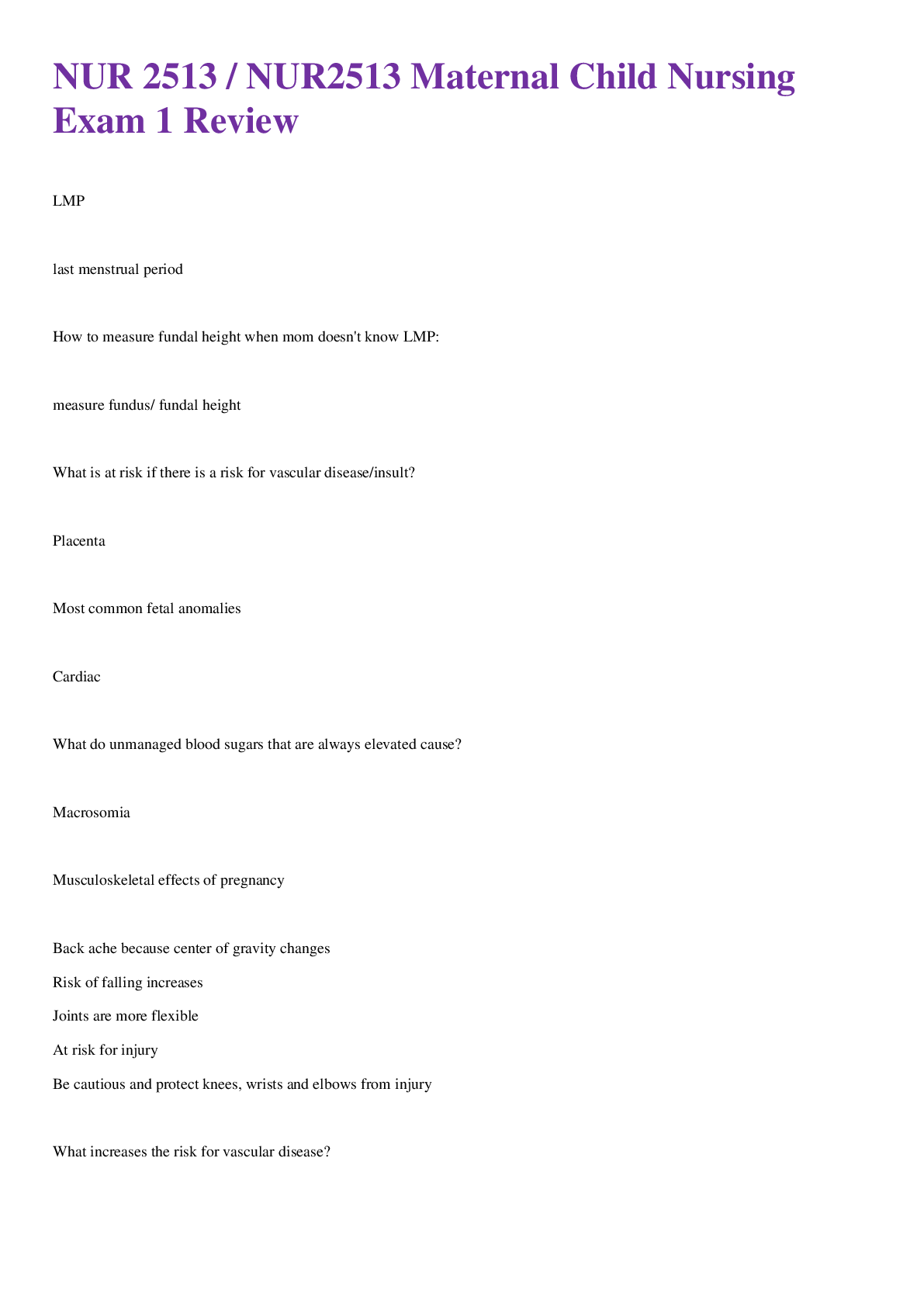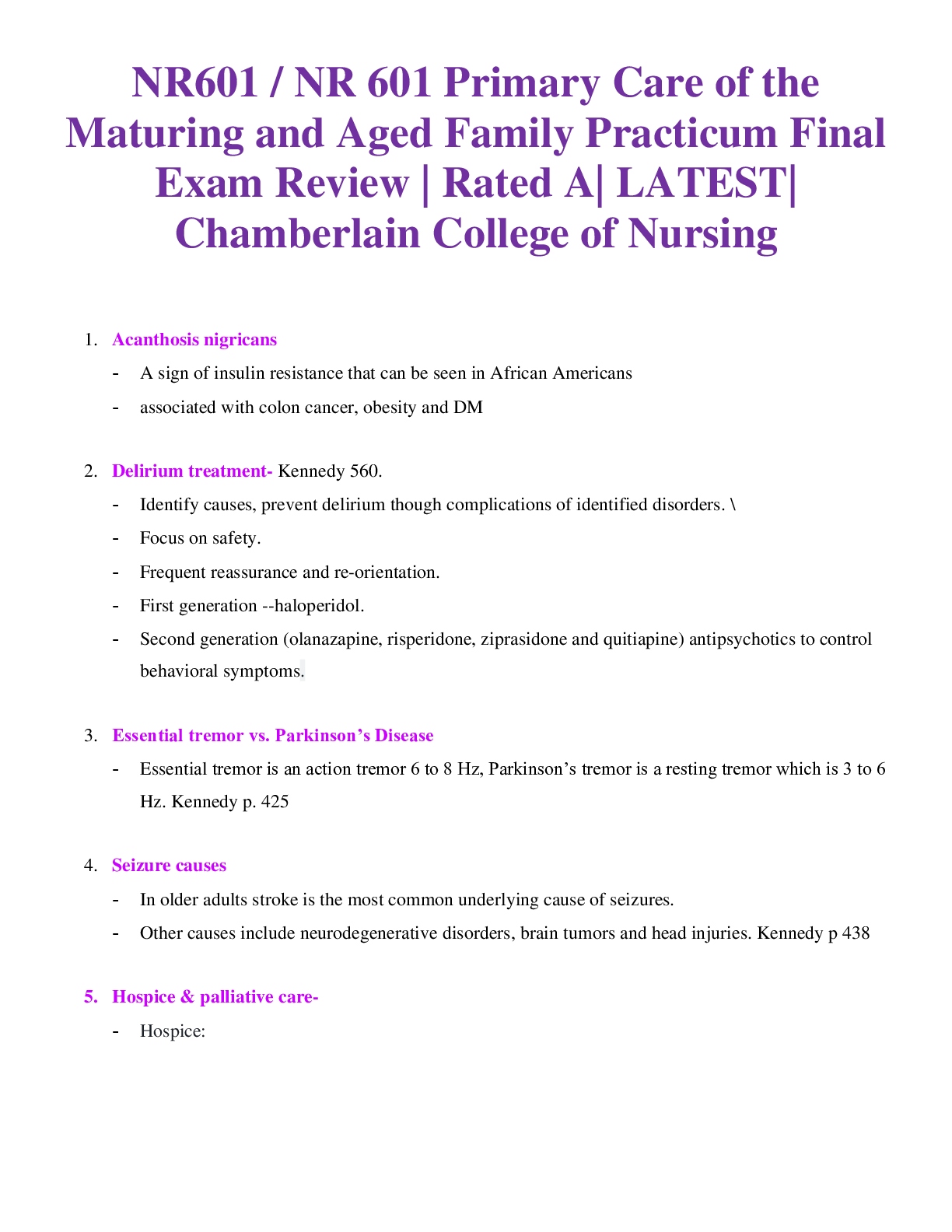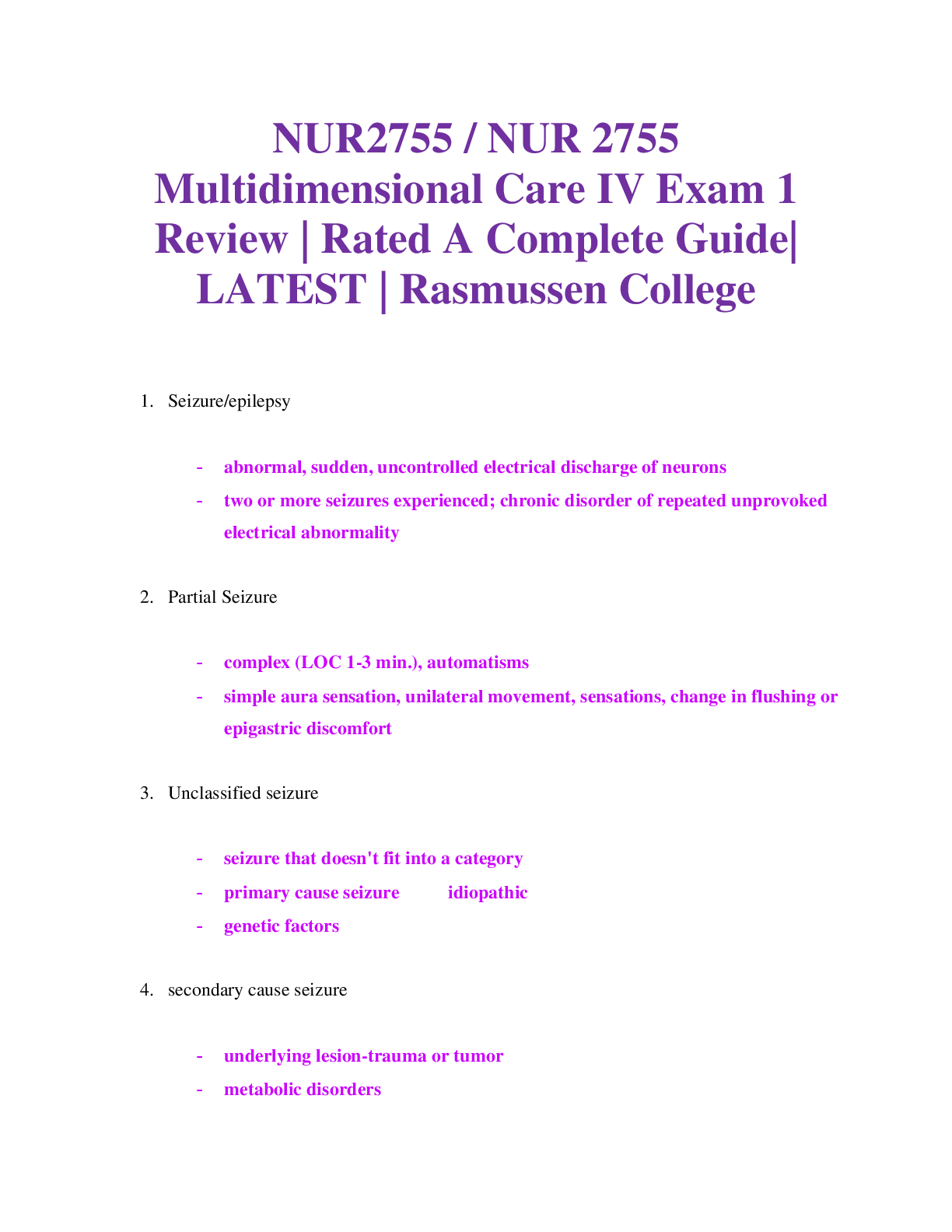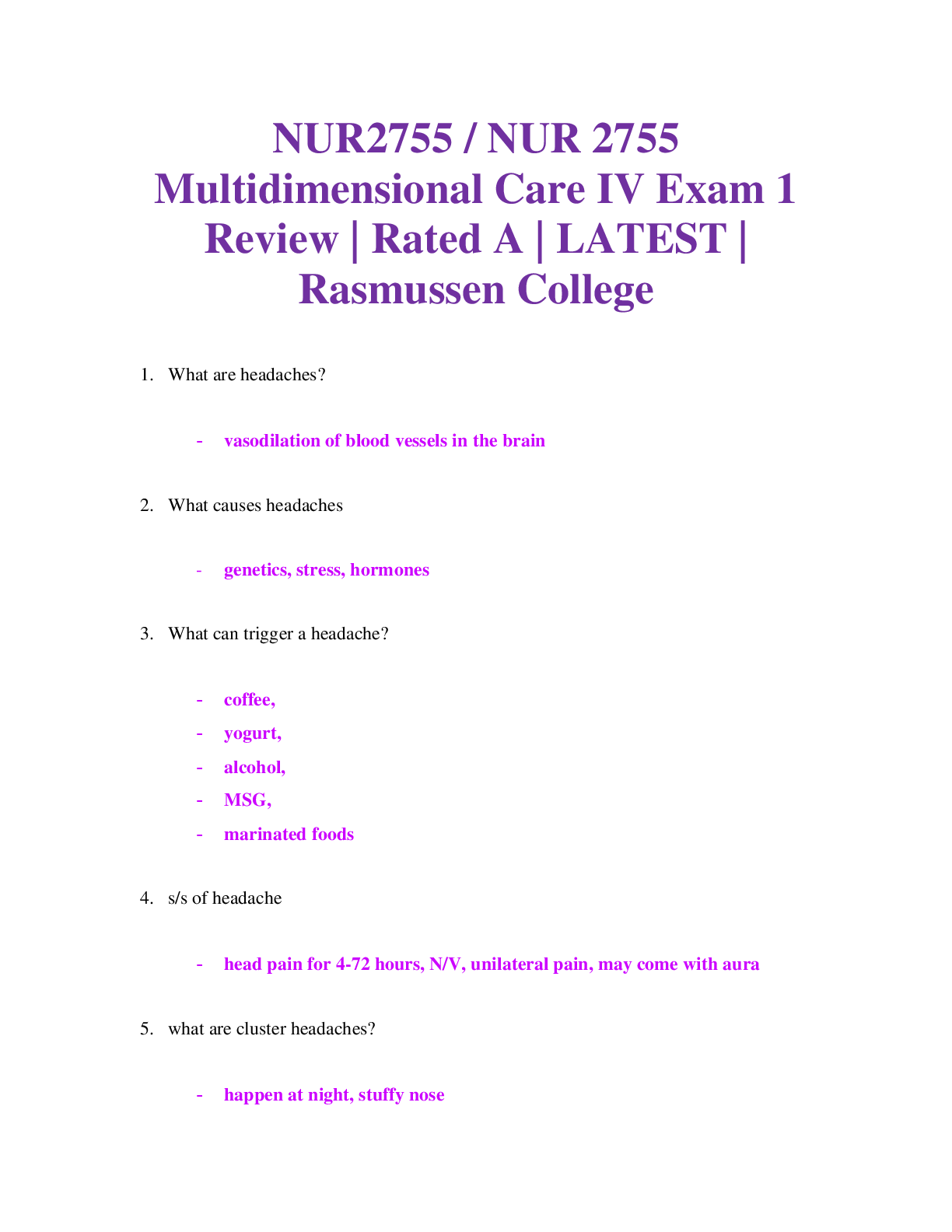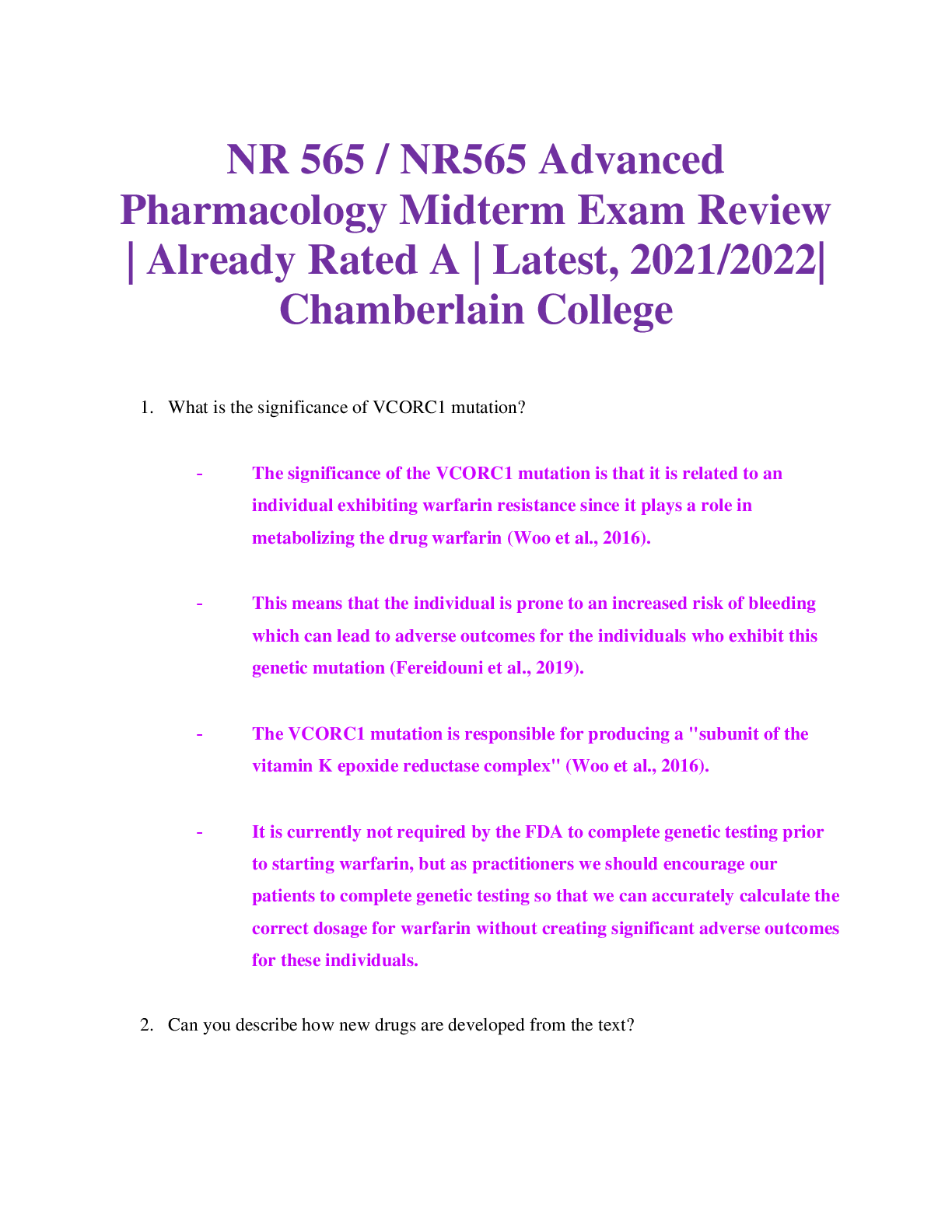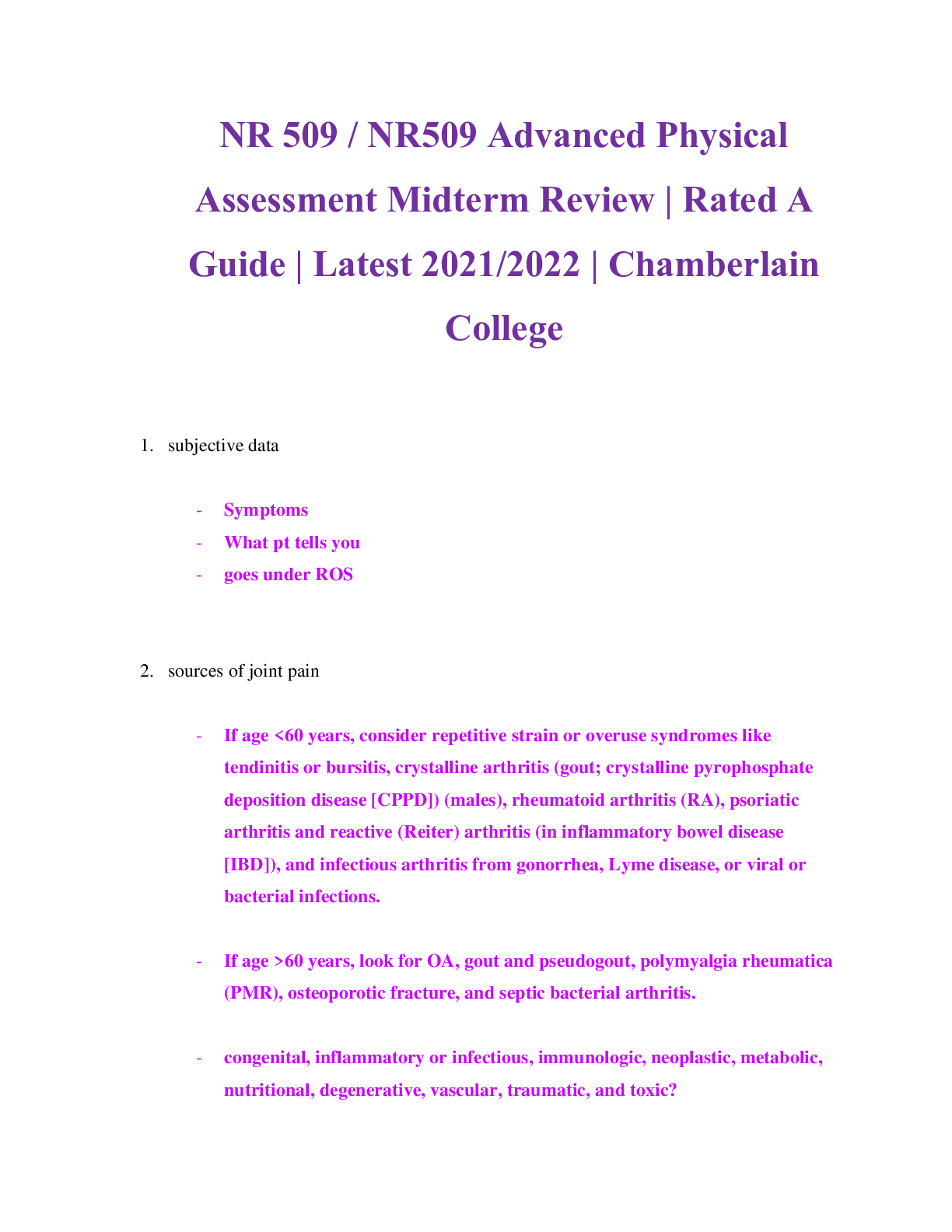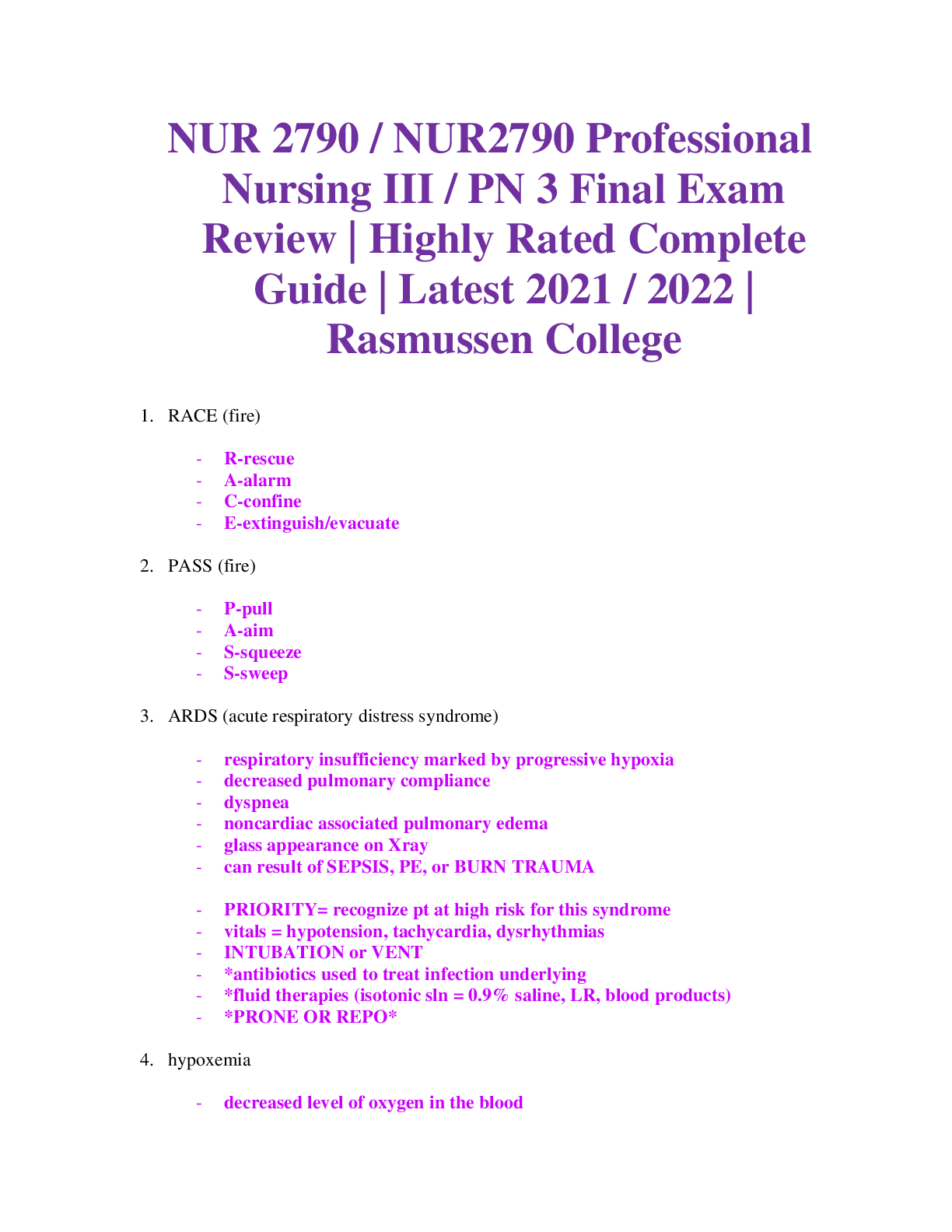Chemistry > EXAM REVIEW > CHEM-120 Week 8 Final Exam Review | Highly Rated Paper for passing exams. (All)
CHEM-120 Week 8 Final Exam Review | Highly Rated Paper for passing exams.
Document Content and Description Below
CHM 120: Final Exam Review Sheet Chapter 1: • know how to apply Scientific method • Know the definitions for hypothesis, scientific law, and scientific theory. • Chapter 2: • Know that ... matter is studied at the macroscopic, microscopic, particulate (molecular) levels • Physical states of matter - Determine physical state of substances (solids, liquids, gases) given descriptions of volume, shape, particles moving, etc. • Be able to identify properties and changes as physical or chemical - Know terms for changes of state: - Melting, freezing, vaporizing, condensation, sublimation, deposition • Law of Conservation of Mass: Chapter 3: • Significant figures or digits - Rounding - In addition, subtraction - In multiplication, division - In measurements (uncertainty) • Scientific notation • Solve problems using dimensional analysis with conversion factors, showing all work • Use dimensional analysis to solve problems • Know English system of units • Metric system - Know the metric prefixes (G,M,k,d,c,m,µ,n) - Be able to perform metric-metric conversions using these prefixes • Use the metric-English conversions provided (1 in. = 2.54 cm; 1 lb=453.6 g; 1 qt=946 mL; 1 gal =3.785 L) • Know 1 cm3 = 1 mL and 1 dm3 =1 L • Volume by calculation • Vrectangular solid = length x width x thickness • Volume by displacement • Density: D = m/V - Be able to determine density, mass, or volume given the other two quantities - Identify what items sink or float in a given liquid given the densities of the liquid and other substances. • Temperature - Know the formulas for converting ̊F to ̊C or ̊C to ̊F and K to ̊C or ̊C to K • Percentage: ratio of parts per 100 parts - Given amount of part and whole, calculate % - Use a given % to solve for part or whole - Calculate weighted averages keeping track of sig figs and decimal places when appropriate. - Know how to use percentage as a conversion factor with appropriate units Chapter 5: Know ideas of matter proposed by Democritus, Empedocles, and Aristotle. • Know the main points of John Dalton’s model, what was later proven wrong and why • Know Plum-Pudding Model vs Nuclear Model. • Know Rutherford’s Alpha Scattering Experiment and what was determined from it - Protons are concentrated in the atomic nucleus, and electrons are outside the nucleus. - The atom is mostly empty space. • The radius of an atom is about 10-10 m, and • the radius of its nucleus is about 10-15 m • Subatomic particles - proton (p+): +1 charge, inside nucleus - neutron (n): neutral, inside nucleus - electron (e–): –1 charge, outside nucleus • Know the names and element symbols for elements #1-56 plus Pt, Au, Hg, Pb, Bi,U,Pu on the Periodic Table. - Given the element symbol, name the Element, or vice versa. Spelling counts! • Know definitions of isotope, atomic number, mass number, atomic mass • Know the atomic mass reported on the Periodic Table is the weighted average of all naturally occurring isotopes for that element. • Calculate the atomic mass of an element given the percent natural abundance and atomic masses of its naturally occurring isotopes (to the correct number of sig figs and decimal places). • The Periodic Table - column = group, family - row = period, series • Representative Elements: A Group Elements - Group IA: alkali metals (except H!) - Group IIA: alkaline earth metals - Group VIIA: halogens - Group VIIIA: noble gases • Transition Metals/Elements: B Group Elements • Inner Transition Elements - Elements in lanthanide and actinide series • Metals, nonmetals, and semimetals: - Know properties of metals and nonmetals - Location on Periodic Table and properties Chapter 6: • Diatomic elements : H2, N2,O2,F2, Cl2, Br2, I2 • ionic compound: a compound consisting of metal cations and anions held together by ionic bonds • molecule (or molecular compound): a compound consisting of nonmetal atoms held together by covalent bonds • Identify a compound as an ionic compound or molecule given its name or chemical formula • Naming cations: - Group IA, IIA, Al, Ag, Zn, Cd: element name + ion - All other metals - Stock system: element name (charge in Roman #s) + ion • Naming anions: nonmetal stem + "-ide" + ion - Know the names and formulas of POLYATOMIC IONS • Naming ionic compounds: - cation name + anion name - IA, IIA, Al, Ag, Zn, Cd don't need Roman #s - All other metals need Roman #s • Nomenclature for Ionic Compounds: - Given formula of a compound, determine name. - Given the name of a compound, give formula. • Naming binary molecular compounds: all nonmetals - Use Greek prefixes when more than one atom of an element is present. - Know the latin for copper, lead, tin and iron • - The lower charge gets a –ous ending • - The higher charge gets an -ic ending • • Know how to name hydrate • • Naming ternary acids: • • H('s) + "-ide" ion → "hydro ic acid" • - e.g. Cl- = chloride ion → HCl (aq) = hydrochloric acid • • H('s) + "-ate" ion → " ic acid" • - e.g. SO4 2- = sulfate ion → H2SO4 (aq) = sulfuric acid • • H('s) + "-ite" ion →" ous acid" • - e.g. NO - = nitrite ion → HNO (aq) = nitrous acid • • • Latin cations • Cuprous • Cu1+ • • Ferrous • Fe2+ • • Stannous • Sn2+ • Cupric • Cu2+ • • Ferric • Fe3+ • • Stannic • Sn4+ • Plumbous • Pb2+ • • Plumbic • Pb4+ • • • • • List of polyatomic ion you must know • • acetate • CH3C – O2 • • iodate • IO3- • • dichromate 2- • Cr2O7 • ammoniu m + • NH4 • • iodite • IO2- • • dihydrogen phosphate – • H2PO4 • bromate - • BrO3 • • nitrate • NO – 3 • • hydrogen phosphate 2– • HPO4 • bromite - • BrO2 • • nitrite • NO – 2 • • perbromate • BrO4 • carbonate 2– • CO3 • • permanga nate • Mn – O4 • • perchlorate – • ClO4 • chlorate – • ClO3 • • phosphate • PO 3– 4 • • periodate - • IO4 • chlorite – • ClO2 • • phosphite • PO 3- 3 • • selenate -2 • SeO4 • chromate 2- • CrO4 • • sulfate • SO 2– 4 • • silicate 4- • SiO4 • cyanide • CN– • • sulfite • SO 2– 3 • • oxalate 2- • C2O4 • hydroxide • OH– • • bisulfate • HS – O4 • • metasilicat e 2- • SiO3 • bicarbona te – • HCO3 • • hypobrom ite • Br O- • • borate -3 • BO3 • arsenate 3- • AsO4 • • hypochlor ite • Cl O– • • hypoiodite • IO- • arsenite 3- • AsO3 • • thiocyana te • SC N- • • • • • • Chapter 7: • • Avogadro's number = 6.022x1023 • • Molar Mass - Be able to get molar masses (in g/mol) for atoms and compounds • • Mole calculations using • – Avogadro's Number (N): 6.022 x 1023 • – Molar masses of atoms and compounds (add the molar masses of constituent atoms) • • Examples of Mole calculations: • - Find # moles given mass • - Find # atoms or molecules given mass • • Percentage composition: • – Calculate the total mass of each element present in the formula of the compound • – Calculate the percentage compositon : • % by weight (mass) of element = (total mass of element present ÷ molecular mass) x 100 • • Determine Empirical and Molecular Formulas – Know empirical formula is simplest ratio of atoms/ions present in compound. • • The Rules are: – If the mass % of the element is given, assume 100g of the sample and estimate the grams of each element present in the compound. – Using molar mass, find the # of moles of each element present in the compound. – Find the simplest whole number of ratios of the elements present in the compound by dividing all mole numbers by the smallest number of moles. The whole number ratios give the subscript of each element present in the compound. – If the mole ratios do not come to whole numbers all subscript will have to be multiplied by a scalar value to give whole numbers. – The molecular formula represents the true or actual formula of the compound. The subscripts for the elements present in the molecular formula are whole number multiples of subscripts of the elements present in the empirical formula. – n = whole number multiple = molecular weight / empirical formula weight – Molecular formula = (empirical formula)n • Determine Empirical Formula through combustion data • Step 1 – We need to find the number of moles of Carbon. Convert grams of Carbon dioxide to moles of carbon dioxide and then to moles of carbon, finally convert moles of carbon to grams of carbon. • Step 2- We need to find the number of moles of hydrogen. Convert grams of water to moles of water and then to moles of hydrogen, finally convert moles of hydrogen to grams of hydrogen. • Step 3- Find the amount of oxygen present in sample. • Mass of oxygen = Overall mass of the compound – (mass of carbon + mass of hydrogen) • Step 4 – Find the number of moles of each element • • Step 5 - Find the simplest whole number of ratios of the elements present in the compound by dividing all mole numbers by the smallest number of moles. If the mole ratios do not come to whole numbers all subscript will have to be multiplied by a scalar value to give whole numbers. • Chapter 8/9 : • • Balancing Equations • • Change coefficients, NEVER subscripts to get same # on both sides in the following order: • 1. Balance metals. 2. Balance polyatomic ions – Keep as one unit. 3. Balance hydrogen atoms. 4. Balance carbon atoms. 5. Balance oxygen atoms. 6. Balance all other atoms. • • Classify reaction types and balance: • • Combination • Decomposition • Single-replacement/displacement • Double-replacement/Precipitation • Acid-Base Neutralization • Combustion Reactions • • Be able TO PREDICT PRODUCTS given a set of reactants • – Use Solubility Rules and the Activity • Series – Memorize solubility rules • REACTION TYPES • • Combination/Synthesis reaction: • metal + nonmetal → ionic compound (s) • • Decomposition reaction: AZ → A + Z • • Special decompositions: M = a metal • • MCO3 (s) MO (s) + CO2 (g) • MClO3 (s) MCl (s) + O2 (g) • MHCO3 (s) MCO3 (s) + H2O (l) + CO2 (g) • • Single-replacement reactions • Activity Series, list of Active Metals, and • Solubility Rules, where reactants are: • solid metal + metal solution/acid • • solid metal + H2O(l) • • Combustion reaction • • CxHy + O2 (g)→ CO2 (g) + H2O (g) • CxHyOz + O2 (g)→ CO2 (g) + H2O (g) • • Double-Displacement/Precipitation Reactions • – precipitate (ppt): insoluble ionic compound • – Use Solubility Rules to determine if a precipitate forms • – Predict products of a reaction given reactants and Solubility Rules • • – Acid-Base Neutralization Reactions • • HX + MOH → H2O(l) + salt • HX + MHCO3 → H2O(l) + CO2(g) + salt • HX + MCO3 → H2O(l) + CO2(g) + salt • NH4OH → H2O(l) + NH3(g) • Strong, Weak and Non‐Electrolytes • – Strong electrolyte: breaks up completely • → many ions present to conduct electricity • • e.g. strong acids & bases, aqueous salts • – weak electrolyte: breaks up to small degree • → Only few ions present to conduct electricity • • e.g. weak acids & bases, insoluble salts • – nonelectrolyte: a molecular compound that forms molecules in water • → No ions • → does not conduct electricity • • Molecular Equations and (Net) Ionic Equations • – Molecular Equation: compounds shown intact • – Complete/Total Ionic Equation: • • shows strong electrolytes as separated ions • • Spectator Ions: ions that remains unchanged during a reaction • – Net Ionic Equation: Shows what substances change in a chemical reaction • • Guidelines for writing Net Ionic Equations: • 1. Complete and balance molecular/ chemical equation • 2. Leave solids, liquids, gases, weak electrolytes (weak acids and weak bases) as compounds; break up strong electrolytes (strong acids, strong bases and soluble salts) • – Know the strong acids and strong bases • – Know the 3 compounds that decompose into water and a gas • • H2CO3 (aq) H2O (l) + CO2 (g) • H2SO3 (aq) H2O (l) + SO2 (g) • NH4OH (aq) H2O (l) + NH3 (g) • 3. Cancel spectator ions • 4. Simplify coefficients if possible • 5. If all reactants and products cancel (all spectator ions) → NR • • • Chapter10: • • Stoichiometry: Use mole-to-mole ratios to relate and calculate amounts of reactants and/or products in a chemical reaction • • Limiting Reagent Problems • • Calculate the mass or volume of product that can be made using the given amounts of each reactant and the balanced chemical equation. • – Solve using the ICE method • 1. Check to be sure you have a balanced equation and set up the ICE table. • 2. Begin filling in the ICE table by writing in the initial mole amount of each species, which can be converted from grams using molar mass. (Fill in the “I” lines—the first line under the chemical equation). • 3. Fill in line C of the ICE table, the change in the number of moles of all species. • ➢ This is represented by the variable x. Remember to bring your coefficient in the balanced equation into the C row and multiply it by x. • ➢ The change for reactants will by minus, since you are losing some of the reactant, and the change for products will be plus, since you are forming product. • 4. Determine how many moles will it require to use up each of the reactants and choose the smallest value to use for x • • 5. Fill in line E of the ICE table, this is by adding the initial moles to the change in moles from rows one and two of your table (remember to substitute in the smallest value of x) • 6. Use the information from row E to determine other information such as the mass of product produced or the amount of excess reactant • • Yields of Reactions • o theoretical yield: amount of product predicted using the balanced equation when limiting reagent is used up (can be calculated) • o actual yield: amount of product one actually obtains (generally given in the problem) • Percent yield= actual yield x 100 theoretical yield • • Chapter 11: • wavelength (λ): distance between peaks • frequency (ν): number of crests passing by a given point in 1 s; given in 1s =hertz (Hz) - Wavelength (λ) is inversely related to frequency (ν) and energy (E): - As λ↑,ν↓, Ε↓ or as λ↓,ν↑,Ε↑ • Electromagnetic Spectrum: - Continuum of radiant energy - Gamma (γ) rays to radio waves - The visible spectrum makes up a small portion - Red light at 700 nm is lower in energy than blue light at 400 nm • Bohr Theory of the Atom - Electrons move in quantized orbits called “energy levels” around nucleus - ground state: electron(s) fill the lowest energy level(s) before any in higher level(s) - excited state: electron(s) in higher energy level(s) before lower levels are full - When an atom absorbs energy, e− jumps from lower energy to higher energy level. - When an e− drops from a higher energy to lower energy level, it releases energy, sometimes as light → atomic emission spectra • Schrödinger’s equation → probability of finding the electron in a given region in space - probability density = electron cloud - “shape” of atomic orbitals • Atomic Orbital Shapes - reflect the “probability density” for an electron in a given orbital - As principal energy level (n=1, 2, 3,…) distance from nucleus increases - Energy levels divided into sublevels (s, p, d, f) - Know shapes and number of s, p, and d orbitals (e.g. one s, three p, five d orbitals). - Be able to write ground state electron - configurations for any neutral atom or ion • Write using full notation and core notation - (Noble Gas abbreviation) - Recognize extra stability gained with filled and half-filled d orbitals (Cr, Mo, Cu, Ag) - Account for electrons gained or lost for ions - Know Representative Elements usually form ions that are isoelectronic with a Noble Gas Know definitions for atomic radius, metallic character, and ionization energy. • Draw atomic orbital diagrams for atoms & ions - Know Pauli Exclusion Principle, Hund’s Rule • • Know Periodic Trends for: • • Atomic radius: - Increases down a group - Decreases left to right across a period because effective nuclear charge increases - Know the trend for Ionic Radius: cation < neutral atom < anion • Metallic Character: same trends as atomic radius • Ionization Energy (IE): - Decreases down a group - Increase left to right across a period - Opposite trend as atomic radius since - IE ↓ as atomic radius ↑ • electronegativity (EN):ability of an atom in a bond to draw electrons to itself - Know F is most electronegative; further away from F, less electronegative an atom. (Know periodic trend) • core electrons: innermost electrons in filled shells • valence electrons: outermost electrons - The group number for each element is equal to its number of valence electrons - Recognize that only valence electrons are gained, lost, or shared during chemical reactions. - Draw Electron Dot Symbols for atoms and ions. • • Chapter 12/13: • • Valence electrons: outermost electrons • • – the group number for each element is equal to the number of valence electrons it has • • Chemical bond: what holds atoms or ions together in a compound • • Ionic bond: electrostatic attraction holding cations and anions together in an ionic compound • • Ionic compounds exist as 3D networks of ions. – The formula indicates the ratio of ions. – At 25°C ionic compounds are solids with very high melting points. • • Electronegativity (EN): ability of an atom in a bond to draw electrons to itself • – Know F is most electronegative; further away from F, less electronegative an atom. • • Covalent bond: sharing of electrons between two nonmetal atoms • • Nonpolar covalent bond: equal sharing of electrons by two atoms with equal EN • – Electron density is even distributed between the two atoms. • Polar covalent bond: unequal sharing of electrons by 2 atoms with different EN • values → dipole (separation of charges) • – Electron density is concentrated towards the more electronegative atom. • – dipole moment: quantitative measure of the polarity of a bond. • – The greater the EN difference, the more polar the bond. • • → Rank different bonds in terms of increasing polarity. • • Use delta notation (δ+ and δ-) and a dipole • Arrow to indicate which atom in a bond is more electronegative. • • Metals exist as nuclei in a “sea of electrons” • special properties of metals resulting from electrons’ freedom to move around • • Be able to identify a bond as ionic, metallic, polar covalent , or nonpolar covalent • . • • Octet rule: atoms bond such that each has 8 electrons, except H only needs 2 electrons. • • Draw Lewis Structure for Molecules • 1. Count total number of valence electrons, then divide by 2 to get # of electron pairs. • 2. Draw skeleton structure • • Least electronegative element in center, and H and F are always outer atoms • 3. Connect all the atoms by drawing lines to represent single bonds • • Distribute remaining electrons around outer atoms, then central atom until each has an octet. • • Make double or triple bonds only if an atom does not have an octet. • • H and F only form single bonds. • • Exceptions to the Octet Rule • • Incomplete octet – Be can have 4 e–s, B can have 6 e–s, and N can have an 7 e–s • • Elements in the third period and lower can have an expanded octet (>8 electrons). • • Resonance structures: two or more structures representing a single molecule with delocalized electrons that cannot be Described fully with only one Lewis structure • – Recognize which molecules require resonance structures. • - Know “delocalized electrons” are shared by three or more atoms in a molecule. • - Note: The delocalized electrons do NOT oscillate between atoms. They are always shared by the atoms, but there’s no other way for us to represent this. • - Know the relative length and strength of bonds with delocalized electrons. • • Valence-Shell Electron Pair Repulsion (VSEPR) Model • • – repulsions between electrons give rise to the shapes or molecular geometries of molecules • • • Molecular Geometry (or Shape) • • A=central atom, X=outer atom(s), • E=lone pair(s) on central atom • • Use Lewis structure and to get 3D shape and bond angles: • - AX2 → linear → 180° - AX3 → trigonal planar → 120° - AX4 → tetrahedral → 109.5° - AX2E → bent → <120° - AX3E → trigonal pyramidal → <109.5° - AX2E2 → bent → <109.5° • Draw Lewis structures for molecules with multiple central atoms. • • – Determine shape and bond angle around each central atom • • – Recognize that in oxyacids (e.g. HNO3, H2SO4) the H atoms are bonded to the O atoms • • Polarity • – Use the shape and electronegativity differences to draw dipoles and determine if the molecule is polar or nonpolar • • Chapter4/14: • • Know the properties of gases. • • Know definitions: vacuum, gas pressure, atmospheric pressure, compressibility • • Recognize that atmospheric pressure decreases with altitude. • • Be able to convert between units of pressure: • • 1 atm ≡ 760 torr ≡ 760 mmHg = 14.7 psi = 101.325 kPa = 29.92 in Hg • • Know how changes in volume, temperature, and number of particles affect gas pressure. • • Use ideal gas law (PV=nRT) to solve for P, V, n, or T (in Kelvins). • R= 0.0821 L∗atm mol∗K • Recognize that STP is standard temperature and pressure, defined at 0°C and 1 atm. • – Molar volume of a gas at STP = 22.4L/mol • • Solve for gas density or molar mass at STP. • • Identify an unknown gas using its gas density or at STP • • Given 2 sets of conditions, solve problems using • P1 V 1 = P2 V 2 • T1 T2 , including canceling variables that stay the same to simplify. Recognize the temperatures • • (T’s) must be in Kelvins. • – Solve for stoichiometry problems involving gases • – Dalton’s Law of Partial Pressure: • • Use Dalton’s Law (Ptotal = P1 + P2 + P3 + …) to solve for total pressure or the partial pressure of one gas in a mixture • - Recognize that when a gas is collected over water, the total pressure is due to water vapor and the gas • – Kinetic Theory of an Ideal Gas • • Know the kinetic theory of gases regarding particle volume, particle motion, attraction, collisions, and the average kinetic energy of each particle being proportional to the temperature. • • Diffusion: gradual mixing of molecules gas molecules by virtue of their kinetic motion • • Effusion: process of a gas under pressure escaping from a container via small opening • - Be able to identify the order that several gases escape out of a container by using their molar masses • • Chapter 15: • • Intermolecular Forces (IMF’s): attraction between 2 different molecules in a liquid or solid • - Identify the type of intermolecular force for a molecule as London/dispersion forces, dipole -dipole forces, hydrogen bonding, or ion-dipole forces - Recognize that polar molecules experience London/dispersion forces as well as dipole-dipole or hydrogen bonding. - Know that hydrogen bonds are the strongest type of intermolecular force, dipole-dipole forces are the next strongest, and London forces are generally the weakest. - Recognize that London forces increase with more electrons—use size to determine relative number of electrons for different molecules. - Know the terms: evaporation, boiling point, vapor pressure, volatile, nonvolatile - Recognize how IMF’s influences vapor pressure, boiling point, surface tension and viscosity. - Given different substances, determine which has the highest boiling point based on IMF’s. - Know ionic and covalent bonds are stronger than all intermolecular forces, even H bonds. - Know the regions and features of a Heating/Cooling Curve • • Use following equations to solve problems: • heat = specific heat)(mass)(ΔT) or heat =molar heat capacity)(n)(ΔT) • Phase change heat equation: heat = mass (ΔH) • 4.184 J = 1.00 cal - Know the definition of a crystalline and amorphous solid - Be able to identify the four types of crystalline solids including properties • • Chapter 16: • • • Solution: uniform mixture of two or more substances as atoms, ions, or molecules (a solute dissolved in solvent) • – solute: component present in smaller amount • – solvent: component present in greater amount • • Know how temperature affects the solubility of gases and solids in solution. • • Know Henry’s Law that Solubility α Pressure (S= k*P) • S1 = S2 • P1 P2 • • Recognize what occurs at the molecular level when a solute dissolves in water. • • Recognize what can be done to increase the rate of dissolving: heating solution, stirring solution, grinding solute into smaller particles • • Know the definitions for unsaturated, saturated, and supersaturated • • Use “Like dissolves like” Rule and the Solubility Rules to predict what substances are soluble/insoluble in or miscible/ immiscible with water or other solvent • • “Like dissolves like” rule • - Polar substances will mix and dissolve in one another, and nonpolar substances will mix and dissolve in one another. • - Polar substances will NOT mix and dissolve in nonpolar substances and vice versa. • - Use the polarity of substances to determine which liquids will mix with one another or which solids will dissolve in water and other polar solvents. • • Mass percent = mass of solute x 100 mass of solution • ppm= mass of solute x 106 mass of solution • ppb= mass of solute x 109 mass of solution • mole Fraction of A= moles of A total moles • Molarity= moles of solute Liters of solution • • Dilution Equation: M1 V1 = M2 V2 • • Molarity, Mass Percent Concentration, and Solution Stoichiometry Calculations • Solve for amount of solute, solvent, or solution given mass percent concentration, molarity, etc. • Use molarity and volume to solve for moles • Be able to use molarity as a conversion factor to get volume • Be able to do limiting reagent problems with molarity using ICE Method including determining the amount of each ion at the end of the reaction • • Chapter 17: • • Know properties of acids and bases • Know Arrhenius, Brønsted-Lowry (B-L) and Lewis definitions for acids and bases • • Given an acid-base reaction, • - Classify each reactant as an Arrhenius and/or a Bronsted-Lowry acid or base - Indicate the conjugate acid-base pairs. - Note that conjugate acid-base pairs differ only by an H+ ion. • • Recognize hydronium ion, • H3O+ = H+ + H2O • Know the strong acids: HCl, HBr, HI, HNO3, HClO3, HClO4, H2SO4. • • Know the common strong bases: LiOH, NaOH, KOH, Ca(OH)2, Sr(OH)2, Ba(OH)2. • • Recognize water rarely ionizes to form ions • → It does not conduct electricity. • → ion-product or dissociation constant for • • Water at 25°C, Kw=[H+][OH−] =1.0x10−14 M2 • • Acidic solutions: [H3O+] > [OH–], pH < 7 • Basic solutions: [OH–] > [H3O+], pH > 7 • Neutral solutions: [OH–] = [H3O+] = 1 x 10-7 M, pH = 7 • • Use pH to classify a substance as neutral, strongly or weakly acidic, strongly or weakly basic • • Calculate pH or pOH using • • pH = -log[H+] and pOH =-log[OH-] • [H+]=10–pH and [OH–]=10–pOH • pH + pOH = 14.00 (exact) • Kw=[H+][OH−] =1.0x10−14 • • Knowing that because pH is a logarithm, the number of sig figs for the H+ concentration determines the number of decimal places for the pH and vice versa. • • Be able to do titration problems as in the lab • • Calculate the pH of a solution after an acid and a base have reacted and by determining the concentration of excess strong acid or strong base that remains • [Show More]
Last updated: 1 year ago
Preview 1 out of 18 pages
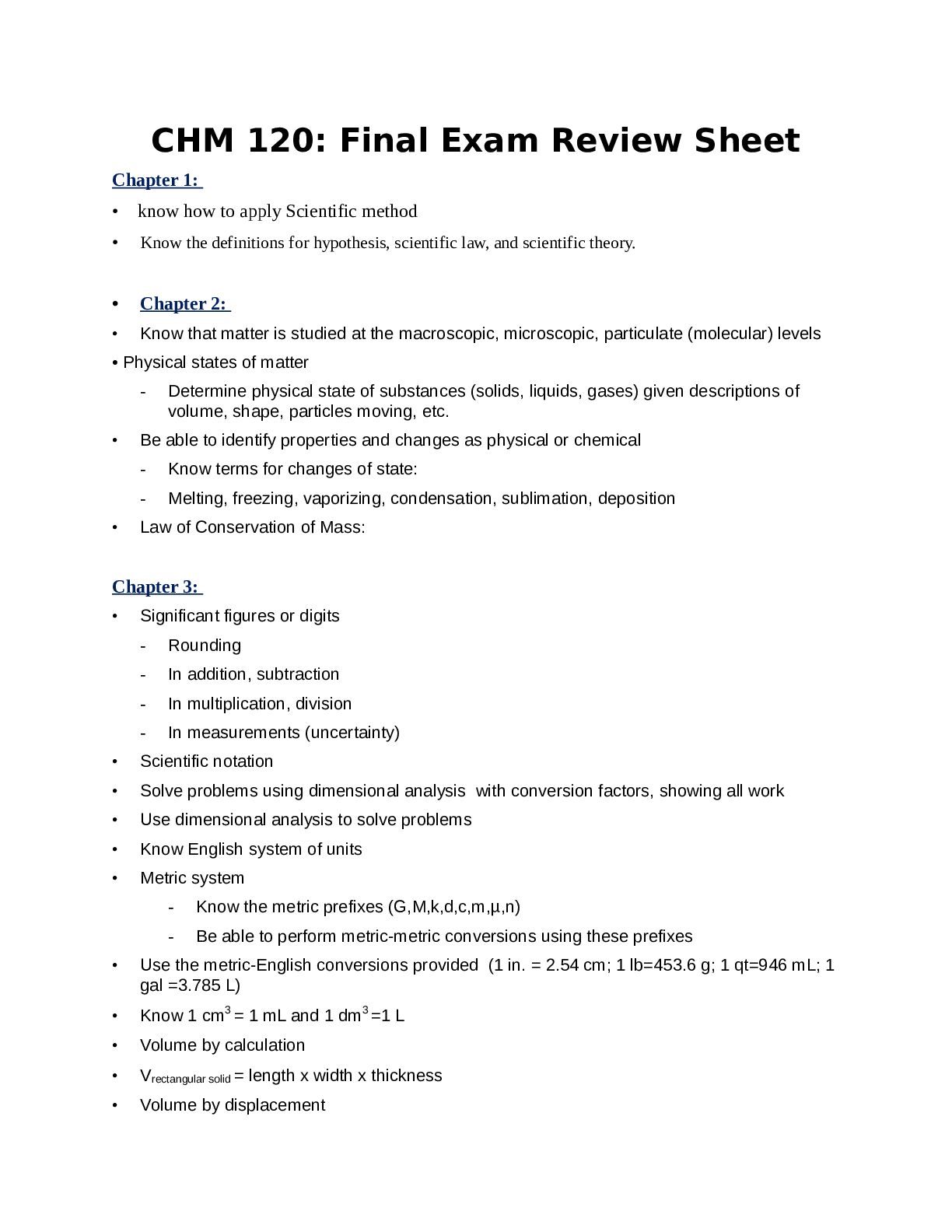
Reviews( 0 )
Document information
Connected school, study & course
About the document
Uploaded On
Nov 30, 2021
Number of pages
18
Written in
Additional information
This document has been written for:
Uploaded
Nov 30, 2021
Downloads
0
Views
66




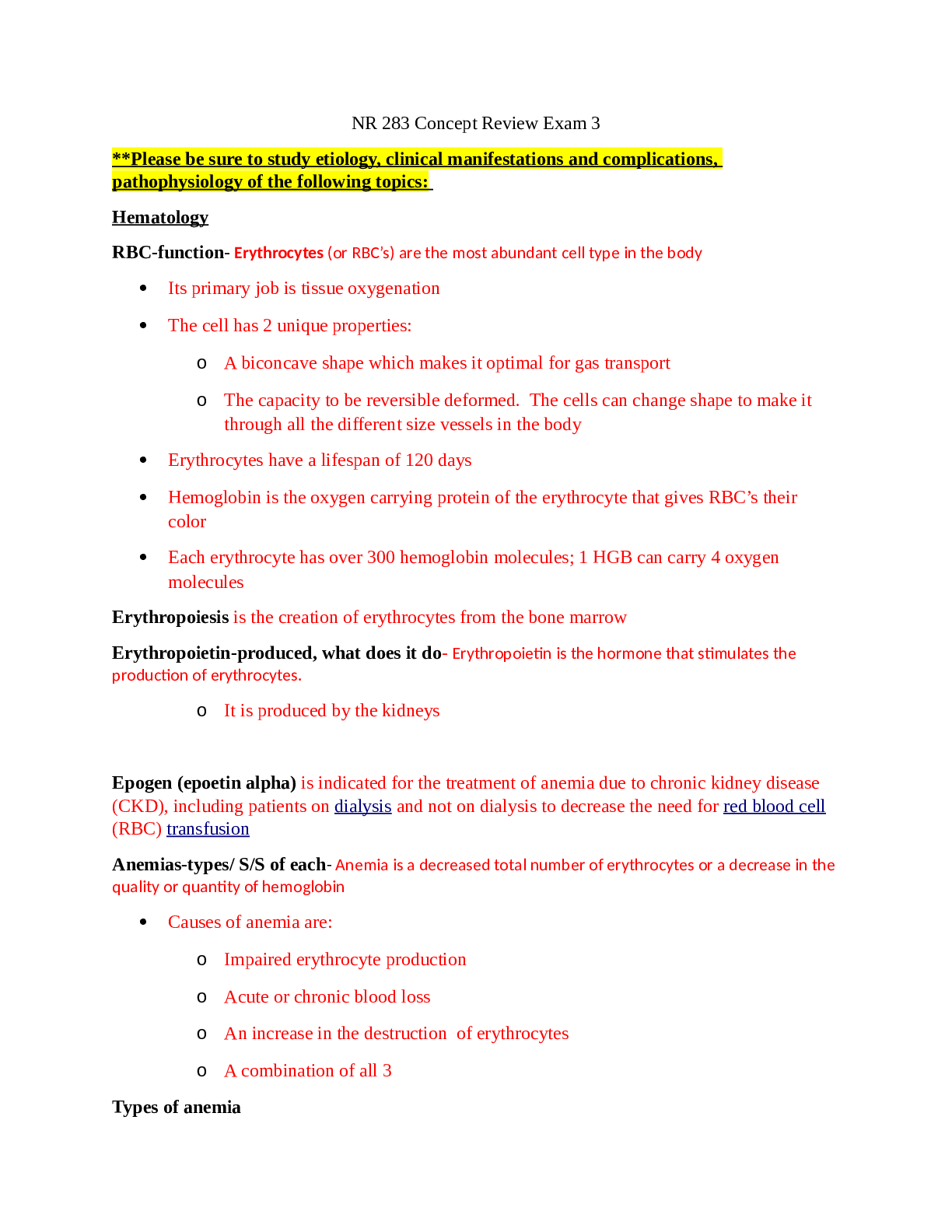


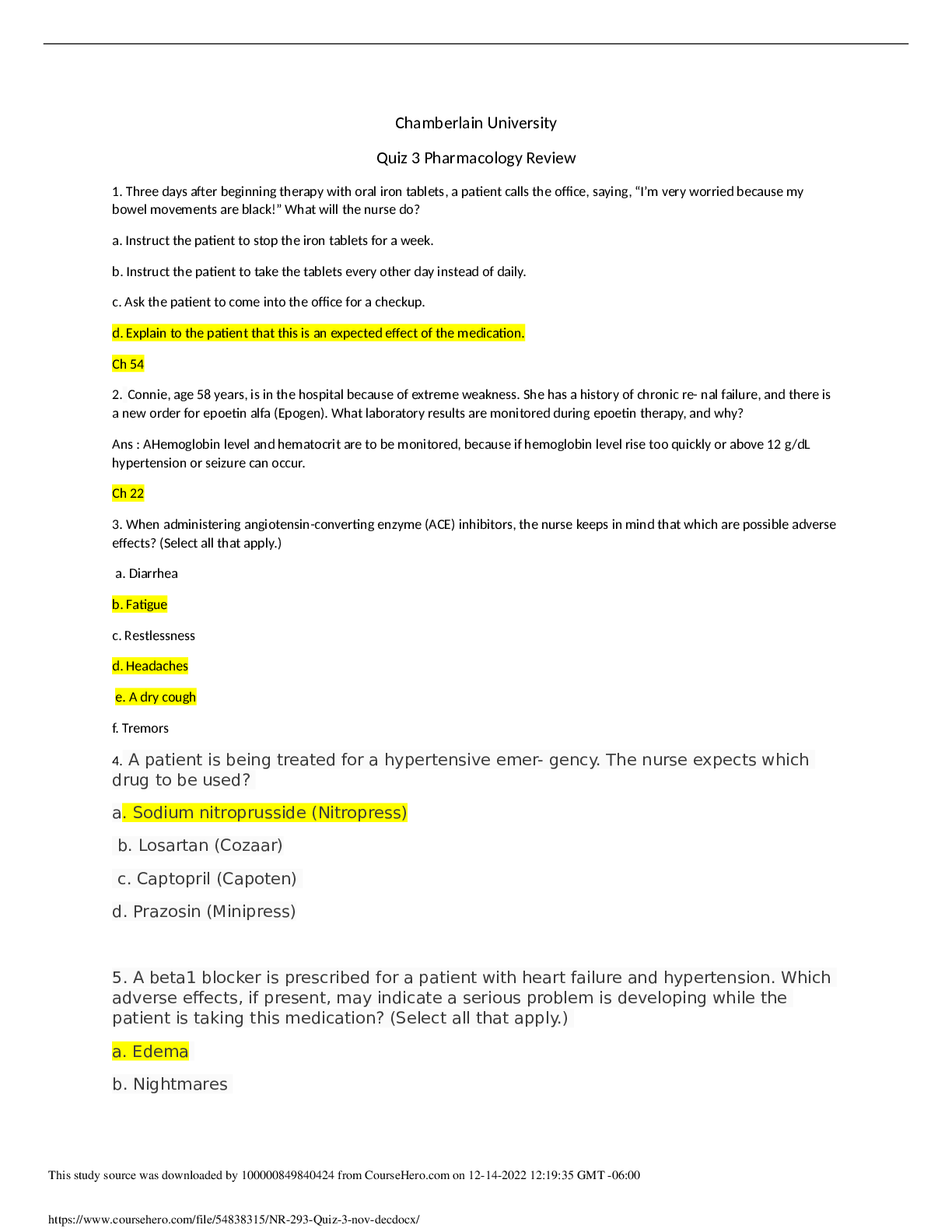

.png)
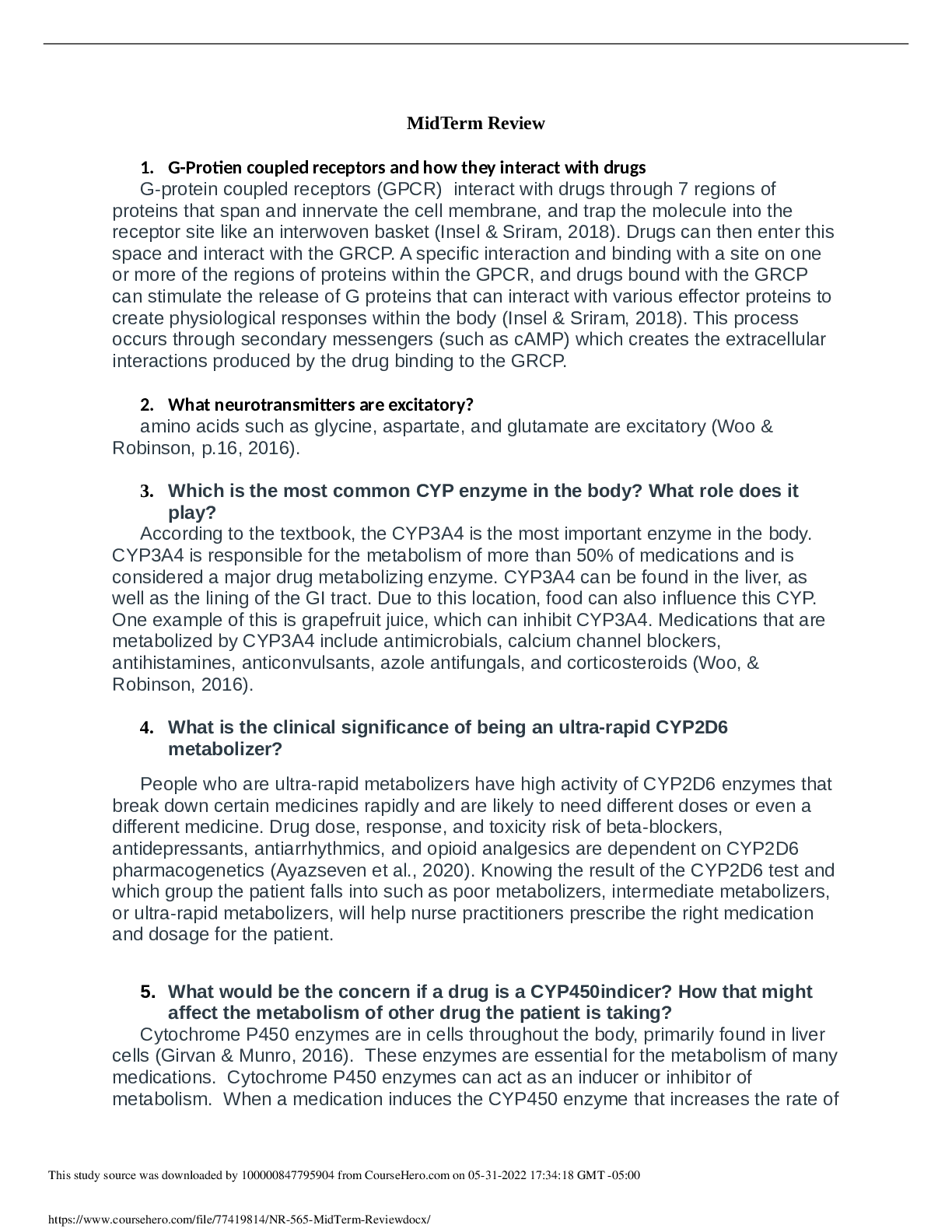
.png)

